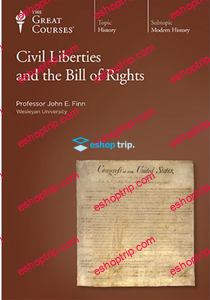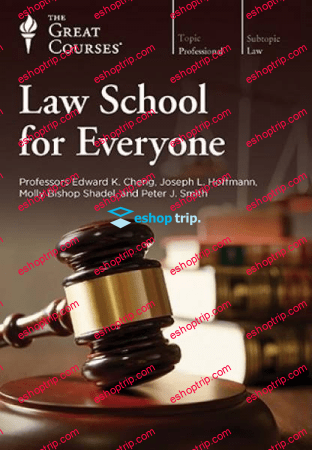WEBRip + AUDIOBOOK | AVI/XviD, ~881 kb/s | 720×544 | 18:26:12 | English: MP3, 160 kb/s (2 ch) | 8.50 GB
Genre: eLearning Video / History, Law
The civil liberties and constitutional rights our nation’s citizens possess—not only in theory, but in the courtroom, where the state can be forced to honor those liberties—are a uniquely American invention. And when we were taught history and learned about the Constitution and Bill of Rights, we were always made aware of that uniqueness, of the extraordinary experiment that gave every citizen of this new nation a gift possessed by no others. But what, exactly, was that gift?
What liberties and rights did the Founders intend us to have? How do we get from what Professor John Finn calls the Constitution’s “wonderfully elastic and vague” language to the finely tuned specifics of the Supreme Court’s decisions about speech, or abortion, or religion?
And what is religion? In forbidding Congress to make any law “respecting an establishment” of religion, or “prohibiting the free exercise” of it, the Founders neglected to define it. The answer is more complicated than it seems.
In fact, as Professor Finn shows in Civil Liberties and the Bill of Rights, almost everything about the Constitution, no matter how unwavering its words might appear, is more complicated than it seems at first reading, leaving a legacy of questions that multiplies with each passing decade.
Why have generations of jurists and legal scholars—not to mention legislators, presidents, and citizens—argued so long and hard about the meaning of what often appears to be unambiguous phrasing? How is it that several differing Supreme Court opinions—even those on diametrically opposed sides of a sharply disputed case—can so often all seem plausible? And how has so remarkably sparse a document as the Constitution nevertheless proven to be so complex a vision of what an ideal polity should be?
A Look at Law as It Relates to Fundamental Questions
In addressing such questions, Professor Finn is interested in far more than law. He emphasizes that this series of lectures, based on Supreme Court opinions from dozens of the Court’s most important landmark decisions, is not a law course where you memorize specific legal tests and principles.
Instead, it has as its subject, says Professor Finn, “the relationship of law to the most fundamental sorts of questions about politics, morality, and human nature.”
Thus, as the lectures examine the legal evolution of specific liberties and rights:
Due process and privacy
Jurisprudence about the death penalty
Freedom of speech and of religion
Equal protection
Habeas corpus.
“There is always a broad theoretical context to consider. We want to know “the overall conception of liberties, rights, and governmental powers that most nearly reflects and promotes our best understanding of the Constitution and the polity it both constitutes and envisions.”
In striving to convey that understanding, Professor Finn encourages us to see that “most of the serious difficulties (and there are many) in the politics of civil liberties arise from conflicts between our commitments to two or more positive values,” or, as Justice Felix Frankfurter once wrote, “What the Greeks thousands of years ago recognized as a tragic issue, namely, the clash of rights, not the clash of wrongs.”
Or, expressed in more practical terms, we live under a Constitution whose meaning is never self-evident, so that, as Professor Finn notes, “There is usually more than one way to understand a constitutional provision, usually more than one way to decide a case,” with “few, if any, uncontested principles or issues or questions in the American constitutional order.”
Balancing Vital Tensions
Civil Liberties and the Bill of Rights explores the tensions that make up that order—tensions, say, between our commitment to self-governance, expressed through majority rule and the other democratic principles, and our simultaneous commitment to constitutionalism and the Bill of Rights, expressed by the need to keep the majority from acting in ways that trample on liberty.
By emphasizing ongoing efforts to grapple with broad philosophical principles that the Founders sought to build into the language of the Constitution, this course provides an ideal complement to the more chronological and descriptive approach offered by The History of the Supreme Court. At the same time, it also complements the perspectives emphasized by our courses in philosophy and intellectual history that examine the more purely theoretical underpinnings of the American experiment. For in focusing on the written opinions of the Court’s members—which are illuminating whether written for the majority, in dissent, or to offer alternative reasons for concurring with a final decision—these lectures directly engage the approach taken by the Court as it has sought not only to understand the language and principles of the Constitution, but also to shape them into the working laws of the land.
Although Professor Finn covers many of the most famous landmark decisions that also appear in The History of the Supreme Court, his course is organized into broad themes, and his method is markedly different. Taking a “liberal arts approach,” Professor Finn looks at constitutional issues from the perspective of their foundations in social, moral, and political theory, thereby addressing “questions about the meaning of justice, questions about the meaning of equality, and questions about the meaning of America itself.”
A Chance to See the Evolution of Principles
An example of Professor Finn’s ability to reveal the law’s evolutionary processes at work comes during his discussion of the famous 1965 decision in Griswold v. Connecticut, when the Court first recognized an explicit constitutional right to privacy.
Professor Finn explains how that idea had first been set forth in an article—coauthored by Boston lawyer Louis Brandeis—in the Harvard Law Review in 1898. Thirty years later—now sitting on the Supreme Court—Justice Brandeis raised the issue again. But he was raising it in a famous dissent from the majority opinion, and it would take 35 more years before another majority opinion, written by Justice William O. Douglas, would finally indicate the Court’s agreement: The Constitution does indeed include, even if not explicitly, a right to privacy—though the Court could not agree on what privacy means.
As an interesting sidelight, Professor Finn notes that the statute against birth control overturned by Griswold had been placed on the books more than 100 years earlier—enacted as one of the very first of the antipornography, antiobscenity laws.
Professor Finn’s discussion of the Griswold ruling, and the long legal gestation of its underlying principle, exemplifies the teaching skills that have been honored repeatedly. Also apparent are his passion for his subject and his ability to convey even the subtlest nuances of the legal and philosophical evolution of issues such as freedom of speech, freedom of religion, school prayer, privacy, equality, reproductive rights, affirmative action, and so much more.
And as you might expect from such difficult issues, this is a course filled with nuance—each side of so many constitutional issues can be presented plausibly. Though none of us will agree with every decision of the Court or the constitutional interpretations on which they are constructed, it is extraordinary to experience, so directly, from throughout our history, in the carefully constructed language of the nation’s leading judges, the deliberate flexibility and ambiguity that so often make even opposing opinions defensible. Indeed, this is among our Constitution’s very greatest strengths.
Professor John E. Finn, Ph.D.
Wesleyan University
Lectures:
00. The Professor’s Biography
01. What Are Civil Liberties?
02. The Bill of Rights — An Overview
03. Two Types of Liberty — Positive and Negative
04. The Court and Constitutional Interpretation
05. Marbury v. Madison and Judicial Review
06. Private Property and the Founding
07. Lochner v. New York and Economic Due Process
08. The Takings Clause of the Fifth Amendment
09. Fundamental Rights — Privacy and Personhood
10. Privacy — The Early Cases
11. Roe v. Wade and Reproductive Autonomy
12. Privacy and Autonomy from Roe to Casey
13. Other Privacy Interests — Family
14. Other Privacy Interests — Sexuality
15. Same-Sex Marriages and the Constitution
16. The Right to Die and the Constitution
17. Cruel and Unusual? The Death Penalty
18. The First Amendment — An Overview
19. Internal Security and the First Amendment
20. Symbolic Speech and Expressive Conduct
21. Indecency and Obscenity
22. Hate Speech and Fighting Words
23. The Right to Silence
24. Why Is Freedom of Religion So Complex?
25. School Prayer and the Establishment Clause
26. Religion — Strict Separation or Accommodation?
27. The Free Exercise Clause — Acting on Beliefs
28. Free Exercise and ‘the Peyote Case’
29. Two Religion Clauses — One Definition?
30. Slavery and ‘Dred Scott’ to Equal Protection
31. Brown v. Board of Education
32. Equality and Affirmative Action
33. Equality and Gender Discrimination
34. Gender Discrimination as Semi-Suspect
35. The Future of Equal Protection?
36. Citizens and Civil Liberties











Reviews
There are no reviews yet.